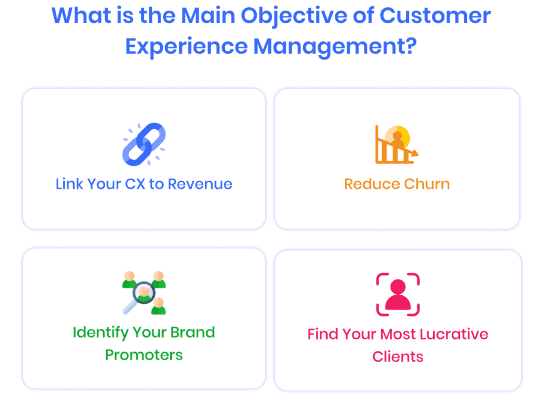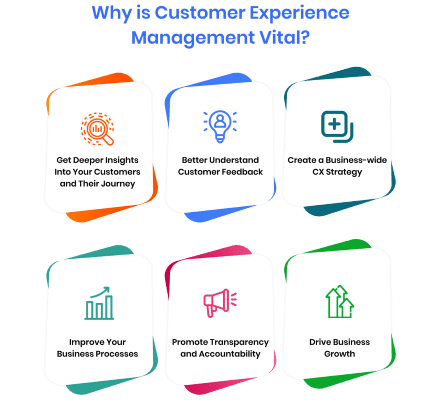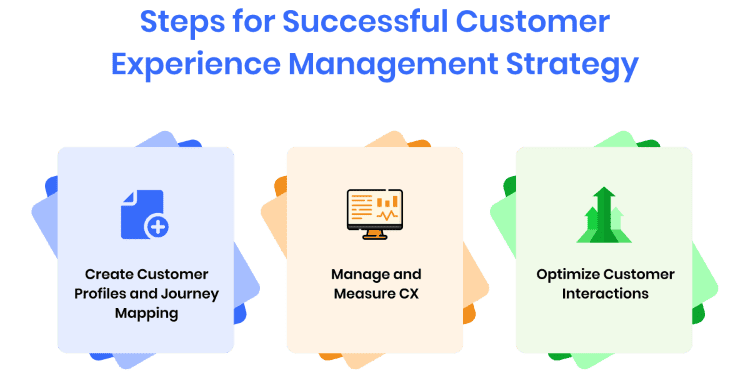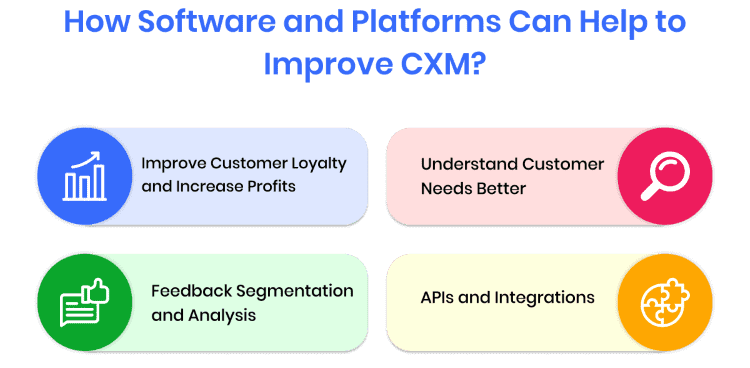A Comprehensive Guide to Customer Experience Management
- October 3, 2022
- 14 mins read
- Listen

Table of Content
Do you know what your customers expect from you? Customers expect to get information about what your business can offer and find out how to reach you exactly when they need it. Plus, they expect a quality experience to be available when, where, and how they want it.
The main objective of CXM is to ensure that the company is able to fulfill all the needs of its customers, starting with the pre-purchase stage and ending with the post-purchase stage.
This article will describe to you what is customer experience management, its objective, its importance, and how tools and software can help you to improve your overall customer experience.
What is Customer Experience Management?
Customer Experience Management (CXM) is an umbrella term that encompasses multiple disciplines, including customer service and support, marketing and sales, call center management, and customer management (CRM).
In simple terms, customer experience management (CXM) is the process of managing the interactions between a brand and its customer in order to improve satisfaction and strengthen customer loyalty.
CXM involves analyzing customer data and using it to improve the customer’s overall experience with the company. For example, CXM might include real-time interaction with customers through Live Chat, or Chatbot to resolve a problem quickly and ensure that the customer receives the best response possible.
It aims to help organizations provide a consistent brand experience by aligning customer needs and expectations with operational capabilities and evolving them through the life cycle of a customer or prospect.
What is the Main Objective of Customer Management Experience?
Today customer experience has a big importance in business. The production of customer experience is the result of teamwork between a set of persons. CX needs to be managed for companies to be successful in their interactions with their customers.
It is important for companies to understand that the way employees treat clients determines the company’s reputation and if clients are not satisfied with this experience it may lead to lost customers.
1. Link Your CX to Revenue
The importance of having a good experience with your brand has been well-proven by many businesses. The more customers remember your experience, the more they will want to return to your business and increase revenue.
However, it is not that easy to develop that kind of experience. You need to make sure the right customer experience management software and people. To deliver the best customer experience it is your job to ensure that you have the right people and tools.
2. Reduce Churn
The goal of the CXM is to reduce the churn rate. This is the expression of the proportion of customers who are lost during a certain period.
Let’s examine why this happens and what you can do to limit the loss of your business.
Customers may change because they:
- Lose interest in you and your product,
- Find a better offer,
- Have problems with billing or delivery.
If you want to minimize the number of customers who leave, you must start by knowing your customers. The best way to do it is to go directly to them, with surveys, or questionnaires and interviews, so you can find out what their preferences are, what kind of products they need, and what solutions would satisfy them the most.
3. Identify Your Brand Promoters
The customer promoter score is a way to understand which customers are the strongest advocates for your company. It’s an indication of the relationship strength a customer has with your company.
Find customers who give you 5 stars and spend the most money. You want to reward these with special perks or future discounts. It will help you understand how strong the relationship is and what you can do to make it stronger.
4. Find Your Most Lucrative Clients
More than ever, business leaders, have to look beyond revenue to be profitable in the long term. In fact, according to Gartner and Bain & Company, 80% of your business profits come from 20% of your customers. Because of this, it’s important to manage each customer’s experience with your business, no matter what their spending level.
That is why it is quite important to find your most lucrative clients and also to decide which experiences you need to improve in order to make all of your clients happy.
Why is Customer Experience Management Vital?
Every brand wants to be able to offer the best possible experience for its clients. And every market analyst agrees that it’s on the number one place in companies’ priority lists.
But when it comes down to making it happen, so many brands struggle with some of the same challenges – from your customer’s point of view, it might look like all brands are created equal and your message is easily lost in the noise of other companies competing for their attention.
Now let’s take a look at some key areas to deal with.
1. Get Deeper Insights into Customer Journey
CXM is the leading way brands deepen their understanding of the customer journey. It helps you discover more about your customers, and their needs and wants, so you can create more personalized and relevant experiences for them.
It’s certainly not new for those of us who’ve been at this for a while. The use of experience management techniques to improve the customer journey is something we’ve been doing for years or even decades in some cases.
But it feels like it’s become a lot less of a secret over the past couple of years. And that’s good. Because there are so many benefits to uncovering new insights into the customer journey.
By listening and responding to what they say, you get a clearer picture of who they are, what they like, and what they think of your product.
2. Better Understand Customer Feedback
Consumer experience is fast becoming the new competitive battleground. Facing stiff competition, brands are using CXM to better understand consumers and improve their digital experience.
Whether you are a company that develops mobile apps or has an existing customer support chat tool, CXM tools uncover insights about the customer experience you could never otherwise anticipate, analyze, or act on.
Specifically, CXM determines when a problem occurred, how it occurred, how it was resolved or not resolved, why it happened and how likely someone is to recommend a company—among other data points.
CXM captures this data as it happens so that you can use it on an ongoing basis to measure performance against your KPIs and plan for improvements in real-time.
3. Create a Business-wide CX Strategy
A business-wide customer experience strategy is the best way to get everyone on the same page and operate with a unified approach.
Forrester’s 2017 CX Index found that only 29% of US organizations have a formal customer experience strategy. The same report showed that of those that do, only 8% create a balanced business-wide approach to CX.
Customer experience management (CXM) is complex. It’s not just about putting a CRM in place.
You have to earn trust by acknowledging mistakes and delivering a consistent experience across all brand touchpoints.
Start with a comprehensive view of your customer. A unified view of your customers lets you deliver an experience tailored for each individual.
4. Improve Your Business Processes
The key to your company’s success is engaging customers who buy products and services because they love your brand and what you do, not because they have no other option.
CXM is the process of collecting, analyzing, and acting on customer feedback. This feedback can come in the form of Net Promoter Score (NPS) surveys, touchpoint data, or insights from social media monitoring campaigns.
And while there are many tools out there designed to help companies understand how well they’re doing in their day-to-day operations and how they compare to the competition—the most important thing any business can do is focus on the customer experience.
5. Promote Transparency and Accountability
Customer experience management is cross-functional. That means every department needs to get behind its CXM goals and be responsible for your CX success.
For example, even if your marketing team’s goal is to sign up a certain number of new customers each week, they need to be accountable for delivering that experience. Likewise, if you’re a human resources manager with an important role in onboarding new hires, then you need to be prepared to provide support when challenges arise.
For all departments, there needs to be a shared understanding of who the customers are, which channels they use, and how they move through the customer experience from beginning to end. Customer journey maps are a great way to help teams visualize a customer’s path so they can more effectively deliver a meaningful experience.
Visualizing the journey also helps identify gaps along the way. For example, it’s essential to check in on customers after they’ve made a purchase, especially when they’ve just become customers. That’s when you have an opportunity to send relevant offers or welcome them along their journey.
Over 60% of consumers are willing to pay more for a better customer experience. As a result, companies have gotten serious about making their customers happy.
6. Drive Business Growth
A new study by Oracle, commissioned by the CXM Institute, confirms what many companies are learning: CXM can drive business growth. In fact, the study finds that companies experience an average of 325% growth in sales, 100% growth in market share, and 90% growth in profits after they adopt CXM as a strategic priority.
There is no doubt that the customer experience is the lifeblood of your business. Your customers are your company. If they’re happy, they’ll return again and again. If they’re unhappy, they’ll take their business elsewhere.
Steps for Successful Customer Experience Management Strategy
It’s clear we can’t do business as usual anymore. The old ways of developing customer experiences are no longer working, and we need new, more human-centered approaches.
Here are some steps you can utilize to build a customer experience management strategy.
1. Create Customer Profiles and Journey Mapping
Having a complete view of your customer profiles and journey map is key to making the right decisions when it comes to creating a successful customer management experience strategy.
From the moment a customer first comes in contact with your business, they are creating memories.
Those memories then form the foundation for their opinion of your brand. You can have awesome social media campaigns or great website design, but if you don’t have a personable and knowledgeable staff on hand to greet and assist your customer, you’re already behind the eight ball.
There are millions of ways customers can interact with your business. The challenge is figuring out which interactions are most important and how to use them to your advantage.
- Having complete customer profiles helps you see where customers fall in their journey with your business.
- This allows you to define which interactions are most crucial along the way.
2. Manage and Measure CX
In 2015, Bain & Company released a study that found that, despite an average increase of more than $2,000 in operating profit per customer, “only one in three companies say they know the difference between a satisfied and an unsatisfied customer.” Companies would do well to take notice and heed the warning.
With so many companies unable to tell if they’re doing well or not, it’s little wonder that most haven’t committed to managing CX.
3. Optimize Customer Interactions
The average customer interaction is worth as much as $100 and is highly dependent on the experience you can provide with that interaction. No matter what industry you’re in, there are ways to optimize that interaction for maximum value.
No matter what your business does, there are many opportunities to optimize customer interactions. It offers a comprehensive solution that helps businesses:
- Capture real-time feedback from customers based on specific interactions
- Deliver personalized messages through interactive digital displays
- Schedule, optimize, and promote content in real-time through dynamic prompts
- Offer patrons fast and easy self-service by leveraging dynamic messaging
- Bring additional channels into your existing CRM platform from verified customer feedback points.
How Software and Platforms Can Help to Improve CXM?
When your business relies on a high customer satisfaction rate, building and maintaining trust is key. Customer experience management software is what an organization and its employees use to better understand and react to the needs of its target audience.
Let’s take a look at some of the keys to how customer experience management tools help to grow the business faster.
1. Improve Customer Loyalty and Increase Profits
The average purchase frequency of loyal customers is 4.2x versus 3.0x for occasional ones.
According to Marketing Science Institute (MSI) poll, 60% of consumers are willing to pay more if the service is excellent. In fact, 82% of them would rather buy from businesses they trust.
However, only 7% of firms say they have a customer management program in place.
To help businesses improve the customer experience and build better relationships with customers.
- In businesses that provide an excellent experience only 14% are more likely to increase profits.
- Companies that are lacking in the customer experience department tend to grow at a slower rate and struggle with low customer retention and high service costs, which ultimately leads to lower profits.
2. Understand Customer Needs Better
Customer experience management is a complex science that combines the best of data and user experience. In the world of big data in finance or any other field, it is not enough to simply collect as much information as possible. It is essential to know what to do with all that information and how to act in an intelligent way. In the end, CXM is about improving the customer journey by creating a personalized customer experience for each user.
The first step towards creating an excellent customer experience is understanding your customers’ needs better. A reliable way of doing this is through a comprehensive survey.
However, surveys are only the first part of the process. The next step involves incorporating that information into the business model, which in turn helps streamline how your business operates. The data you gather informs how your business develops its organization’s structure and its processes while also optimizing its marketing strategy and customer service.
3. Feedback Segmentation and Analysis
Customer experience platforms collect data from multiple sources and platforms like customer service, social, surveys, and other customer interactions. These customer data can be segmented into different bios where customer feedback helps the brand to understand what variations work and what needs to be refined. Feedback segmentation and analysis give marketers a holistic view of the customer, driving a customer-centered approach to achieving overall business goals.
With customer experience platforms, each interaction is registered and monitored across the customer journey. This approach allows marketers to see what customers are saying about their products and services, thus gaining valuable insight into how to improve their overall business strategy.
This important customer data collected from each action is channeled into relevant marketing and sales functions to help align efforts and resources with customer needs.
4. APIs and Integrations
With APIs and integrations, businesses can gather insights into their customers’ experiences and resolve issues before they become problems. From increased sales and loyalty to reduced costs, more businesses are realizing the benefits of APIs and integrations — making it easier to deliver great customer service at every touch point of the customer journey.
The REVE Chat is a comprehensive set of APIs and integrations that customize and streamline the CX management process. It allows various departments within a company to share information while providing data-driven insights back to users, all in real-time.
Why REVE Chat is an Ideal Customer Experience Management Software?
The importance of personalized communication with customers is essential for businesses to ensure the best possible customer experience. There are many different types of platforms available out there, each with its own unique advantages and disadvantages.
In order to determine which platform is the best fit for your business, you should think about what your company’s goals are. Are your goals centered around improving conversion rates and quality of service? If so, then a platform such as REVE Chat will be able to provide you with the elements you need to grow your business.
REVE Chat is an omnichannel customer communication tool built for businesses to deliver high-quality customer communication online. The platform facilitates real-time communication between sellers and buyers from the shopping cart to email and live chat. With REVE Chat, companies can increase sales, reduce costs, improve customer experiences, and proactively create accurate, actionable data.
Start improving your customer satisfaction rate with REVE Chat customer experience management software. Sign up and enjoy 14 days free trial. No credit card is required.







